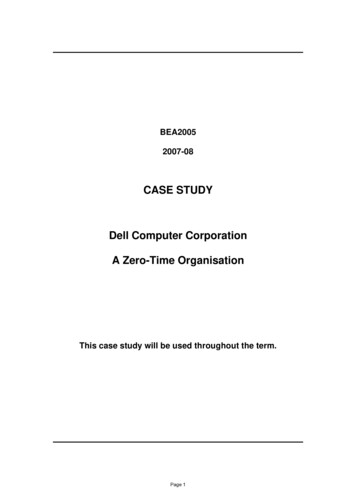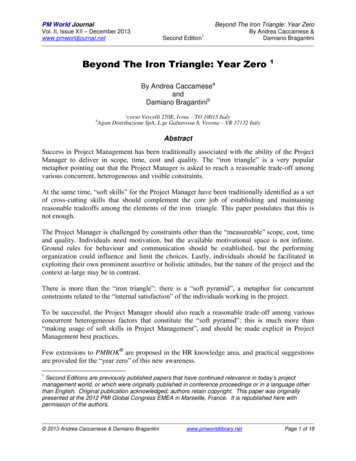
Transcription
Defeating Samsung KNOXwith zero privilegeDi Shen (@returnsme)KEEN LAB TENCENT (@KEEN LAB)
OVERVIEW OF KNOX 2.63KASLR (SAMSUNG’S IMPLEMENTATION)3REAL-TIME KERNEL PROTECTION (RKP)4KERNEL CODE PROTECTION4KERNEL PAGE AND PAGE TABLE PROTECTION5KERNEL DATA PROTECTION5KERNEL OBJECT PROTECTION6CREDENTIAL VERIFYING IN SECURE WORLD7DATA FLOW INTEGRITY (DFI)7SUMMARY OF RKP AND DFI8SELINUX ENHANCEMENT9REMOVED SELINUX ENFORCING9DISABILITY OF POLICY RELOADING9REMOVED SUPPORT OF PERMISSIVE DOMAIN9BYPASSING TECHNIQUES10REQUIREMENTS10VULNERABILITIES I USED IN THIS CHAIN10EXPLOIT CHAIN11KASLR BYPASSING11DFI BYPASSING12SELINUX BYPASSING13GAIN ROOT142
Defeating Samsung KNOX with zeroprivilegeDi Shen (@returnsme)Keen Lab Tencent (@keen lab)Overview of KNOX 2.6Bypassing KNOX is necessary if you are trying to apply a rooting exploit on Samsung devices.In April 2016 I found CVE-2016-6787 affected large numbers of Android devices shipped with3.10 & 3.18 Linux kernel, and successfully make out the rooting exploit. However, the originalexploit wasn’t working on Samsung Galaxy S7 edge. KNOX introduced many mitigations inAndroid kernel to prevent from local privilege escalation, including KASLR, DFI, andSELinux enhancement.In this section we will have a look at the kernel defence implemented by Samsung KNOX 2.6,all analyses are based on Galaxy S7 edge, the Qualcomm-based devices, Hong Kongversion.(SM-G9350)KASLR (Samsung’s implementation)Samsung implemented its own KASLR for arm64 Linux kernel earlier than UPSTREAM. Byenabling CONFIG RELOCATABLE KERNEL, kernel will be complied as a PIE executable.Bootloader will pass two parameters to the start entry of Linux kernel, one is the physicaladdress of kernel, another is the actual load address of kernel. Kernel may save the two addressto boot kernel offset[3], calculate the randomized offset of kernel.3
Then relocate kernel() handles kernel relocating,it’s very similar to a aarch64 linker in userspace. There is a ‘.rela’ section, contains entries of relative addresses.Real-time kernel protection (RKP)RKP is implemented in both Linux kernel and secure world. The secure world can be TrustZoneor hypervisor, it depends on devices model, for S7 the secure world is TrustZone. According tosamsungknox.com, RKP provides following security features:1. “completely prevents running unauthorized privileged code”2. “prevents kernel data from being directly accessed by user processes”3. “monitors some critical kernel data structures to verify that they are not exploited byattacks”rpk call() is the syscall entry of RKP. Many critical kernel functions call this function to enterthe secure world, including SLAB allocation and deallocation routines, page tableoperations,and copy/override/commit credential routines.Kernel code protectionThis is not an exclusive feature for KNOX 2.6. Most 64 bits Android devices had enabled“KERNEL TEXT RDONLY” while compiling, so that the “.text” section is not writable.“.data” section is not executable as well. Based on ARM’s feature Privileged eXecute Never(PXN), user code is never executable in kernel mode.4
Kernel page and page table protectionRKP provides read-only kernel pages for sensitive kernel data and objects, only secure worldcan allocate,de-allocate and manipulate these kernel pages. So these pages’ table entries shouldbe protected from page attribute manipulation as well. When kernel need to access protectedPGD/PTE/PMD/PUD, related routines will call rpk call() to enter the secure world.Kernel data protectionData protection is based on page protection. Some critical global variables are stored in section“.rkp.prot.page”, pages in this section cannot be overwritten any more after kernel initialization.So far following variables are protected by RKP:struct cred init credstruct task secrity struct init secstruct security oprations security ops5
Kernel object protectionThe kernel objects in kernel heap also can be protected by RKP. So far following objects (andtheir kmem cache) are protected:cred jar ro : credential of processestsec jar: security contextvfsmnt cache: struct vfsmount – mount namespaceThese objects are all read-only in kernel/user mode. Allocation, de-allocation and overwritingmust be done in secure world. For example, in original Linux kernel, kernel can calloverride creds() to update a process’s credential. But in Samsung’s repository, this function isreplaced by rkp override creds() , it will allocate credential and security context in read-onlykmem cache then call rkp call(cmid 0x46) to ask secure world to update process’s credential.6
Credential verifying in secure worldOn Galaxy S6, attacker can simply call rkp override creds() to bypass the kernel objectprotection and escalate privilege, but this trick isn’t working for S7 any more. RKP add anotherchecking to verify if the submitted new credential is a legal one.Uid checking()Before adbd and zygote start up, uid checking will always return ALLOW; after thatunprivileged process(uid 1000) cannot override the credential with high privilege (uid 0 1000)any more. That is why the old tricks on S6 was not working any more. However, in fact, on S7you call still use this trick to modify the kernel capabilities of your current credential, evenchanging uid is not permitted.Integrity checking()This checking will check if current credential belongs to current process, and check if currentsecurity context belongs to current credential. This is very similar to functionsecurity integrity current() in Linux kernel. We’ll analyze this function in next section “DataFlow Integrity”.Data Flow Integrity (DFI)There is another old trick to manipulate current credential. For now, we know that credentialsare read-only, what if we reuse init process’s credential in current context?7
Actually it’s not working because of Data Flow Integrity. DFI defines additional members instruct cred{}bp task is a pointer to this cred’s owner, bp pgd is apointer to process’s PGD. During committing/overriding anew credential in secure world, RKP will record the ownerof this credential in bp task. RKP also record the owner ofstruct task security struct{} in bp cred.security integirity current() is a hard-coded hooking inevery SELinux routines, so almost every Linux syscall willat least call this checking function once to check data’sintegrity.Summary of RKP and DFIWith RKP enabled, even we achieved arbitrary kernel memory overwriting, we cannot 1)manipulate credentials and security context in kernel mode; 2) point current credential toinit cred; 3) call rkp override creds() to ask secure world to help us override credential withuid 0 1000. But we still can: 1) invoke kernel functions from user mode by hijackingptmx fops- check flags(int flag), note that the number of parameters is limited, only low 32bit8
of X0 is controllable; 2) Override credential with full kernel capabilities (cred- cap **); 3)overwrite other unprotected data in kernel.SELinux enhancementRemoved selinux enforcingOn other Android devices, SELinux can be simply disabled by overwriting “selinux enforcing”to 0 in Linux kernel. Samsung removed this global variable in kernel by disablingCONFIG SECURITY SELINUX DEVELOP long time ago.Disability of policy reloadingAnd also init process cannot reload SELinux policy after system initialized, which means afterAndroid initialization, attacker cannot simply change its domain to init and reload a customizedpolicy to bypass SELinux.Removed support of permissive domainFurthermore, permissive domain is not allowed neither. The permissive domain was officiallyused by Google before Lollipop for policy developing purpose. On KitKat you can see that initis a permissive domain, which means even SELinux is enforcing, init process still can doeverything it want without a permission deny from kernel.After that Google remove the permissive domain on Lollipop’s SELinux policy, but permissivedomain is still allowed by kernel’s SELinux access vector checking routing. If you can reload acustomized SELinux policy with permissive domain declared, it’s still a good way to bypassSELinux. Permissive domain’s access vector database will be marked asAVD FLAGS PERMISSIVE, as you can see in avc denied(), with this flags all deniedoperation can be allowed.9
Samsung modified the function avc denied(), this function always returns –EACCESS withoutany exception on S7.Bypassing techniquesRequirementsTo build an exploit chain to root Galaxy S7, at least you need two vulnerabilities, one for leakkernel information, another for arbitrary kernel memory overwriting. Combined with followingbypass techniques, a fully working exploit chain will be explained in this section.Vulnerabilities I used in this chainThe information leaking vulnerability will be disclosed in section “KASLR bypassing”.Another one is CVE-2016-6787 found by myself in April 2016, an use-after-free due to racecondition in perf subsystem. Note that the patch for “kernel.perf event paranoid” was notapplied on Android at that time, so that this bug could be triggered by any local application.And also you can use any other exploitable kernel memory corruption bugs instead of this one.The root cause of this vulnerability is that moving group in sys perf event open() is not lockedby mutex correctly. By spraying kernel memory you call refill struct perf event context{} andcontrol code flow by triggering ctx- pmu- pmu disable(X0).To make this exploit 100%10
reliable is another long story. A full description of exploiting CVE-2016-6787 may disclose inthe future.Exploit chainRooting a standard Android device normally requires 4 steps.Arbitrary kernel memoryoverwritingOverwriteptmx fopsOverwriteaddress limitOverwrite uid,security id,andselinux enforcingRooting S7 requires some additional steps to bypass KNOX mitigationBypass KASLRArbitrarykernel memoryoverwritingOverwriteptmx fopsOverwriteaddress limitBypass DFIBypassSELinux forSamsungGain rootprivilegeKASLR bypassingOn S7 there are some debugging files in /proc fs, the following are TIMA logs.Kernel pointers leaked in global readable file /proc/tima secure rkp log. At 0x13B80 of thisfile, it leaked the actual address of init user ns. “init user ns” is a global variable in kernel’sdata section, so with the leaked information, we can calculate the loading offset of Linuxkernel, and bypass KASLR.11
DFI bypassingThe main idea is asking kernel to create a privileged process for me, so that I’ll not break anychecking rules defined by RKP and DFI. However I cannot call call userermodehelper() viaptmx fops- check flags(int), as I’ve explained above, this function have 4 parameters while Ican only pass one from user mode. So I choose to call orderly poweroff() instead.orderly poweroff() will create a worker thread to create a new user mode process“/sbin/poweroff”. The path of this executable file is poweroff cmd which can be manipulated.So the bypassing steps are 1) Call rpk override creds() via ptmx fops- check flags() tooverride own cred to gain full kernel capabilities 2) Overwrite poweroff cmd with“/data/data/***/ss7kiler” 3) Call orderly poweroff() via ptmx fops- check flags() 4) Modifyss7killer’s thread info- address limit 5) ss7killer call rpk override creds() to change itscontext from u:r:kernel:s0 to u:r:init:s012
Till now we ask kernel thread to create a root process “ss7killer” with u:r:init:s0 securitydomain. However, this process is still limited by SELinux, to gain full access we need to bypassSELinux.SELinux bypassingWe need to cheat kernel that SELinux is not initialized yet, this status depends on globalvariable ss initialized, which is not protected by RKP. If ss initialized is set to 0, all securitylabels will be reset to none except kernel domain, all operations can be allowed by SELinuxhooking routines, loading customized policy and reinitializing SELinux can be possible.13
After setting ss initialized to 0, we need to load SELinux policy in user space, modify it withlibsepol API. The policy database locates at /sys/fs/selinux/policy. Then insert allow rules intothe database, allow domains including “untrusted app”, init, toolbox to do everything. Finally,we should recover ss initialized ASAP, otherwise other process with none security label maycreate none label files and corrupt the file system.Gain rootFinally we got a full root access on Samsung Galaxy S7 with KNOX 2.6.14
To build an exploit chain to root Galaxy S7, at least you need two vulnerabilities, one for leak kernel information, another for arbitrary kernel memory overwriting. Combined with following bypass techniques, a fully working exploit chain will be explained in this section. Vulnerabilities I used in this chain











